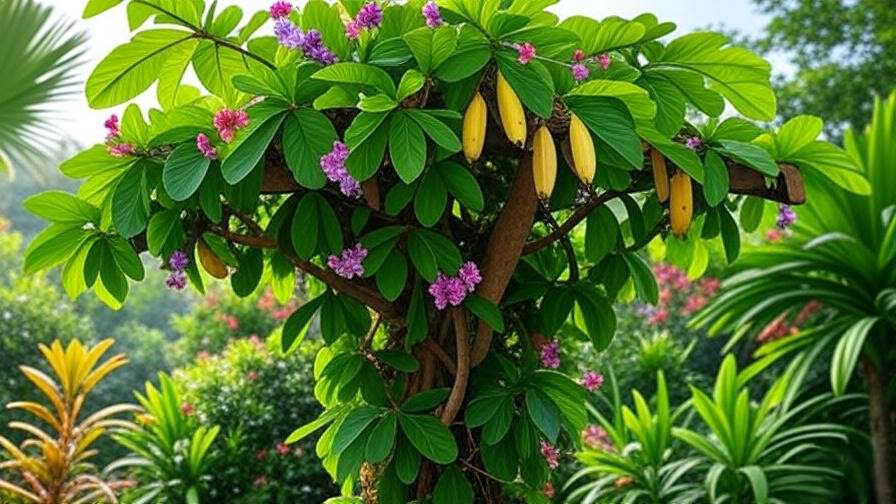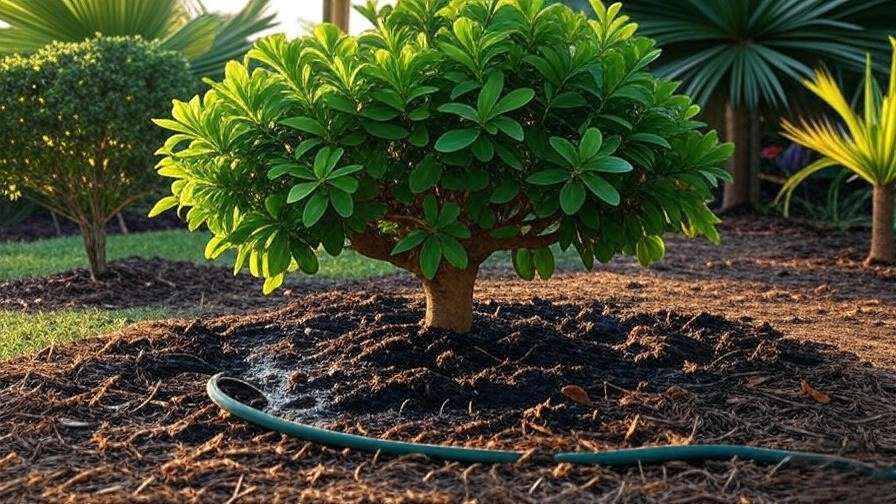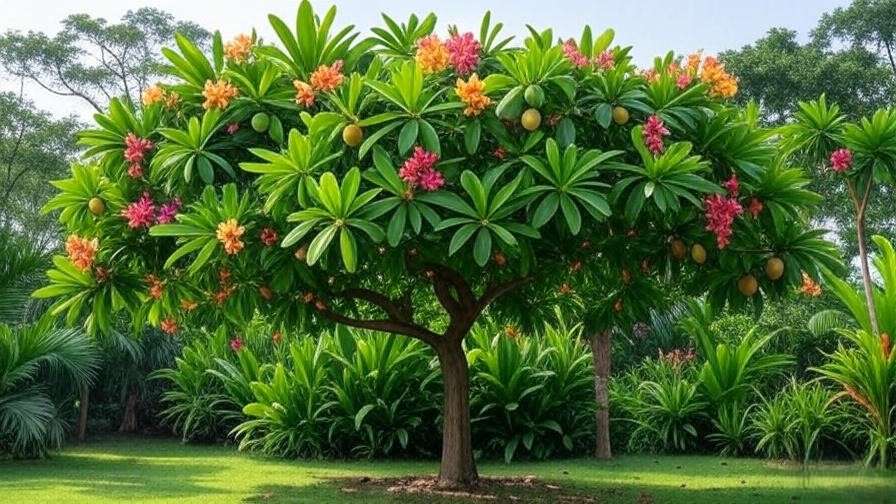Imagine transforming your garden into a tropical oasis with the vibrant blooms and delicious fruits of a tumbo tree! Known scientifically as Passiflora tarminiana, the tumbo tree is a fast-growing vine that brings exotic beauty and edible rewards to any landscape. Whether you’re a seasoned gardener or a curious beginner, this comprehensive guide will empower you to grow and care for a thriving tumbo tree with confidence. From planting tips to troubleshooting common issues, we’ll cover everything you need to cultivate this stunning plant successfully. With insights drawn from years of tropical plant care experience and backed by horticultural expertise, this article is your ultimate resource for tumbo tree success. Let’s dive in and make your garden bloom! 🌞
1. What Is a Tumbo Tree? An Overview 🌿
1.1 Botanical Background
The tumbo tree, or Passiflora tarminiana, is a vigorous climbing vine native to the Andean highlands of South America. Belonging to the Passifloraceae family, it’s closely related to passionfruit vines but stands out with its elongated, banana-like fruits and striking tubular flowers. These blooms, often pink or purple, attract pollinators like bees and hummingbirds, making the tumbo tree a favorite in tropical and subtropical gardens. Its adaptability to various climates (USDA zones 9–11) and rapid growth make it a versatile choice for home gardeners.

1.2 Why Grow a Tumbo Tree?
Why choose a tumbo tree for your garden? Beyond its ornamental charm, this vine offers multiple benefits:
- Aesthetic Appeal: Its lush green foliage and vibrant flowers create a stunning focal point for trellises, arbors, or fences.
- Edible Fruit: The tumbo fruit is packed with vitamins A and C, offering a tart, refreshing flavor perfect for culinary use.
- Ecological Benefits: The flowers attract pollinators, supporting local biodiversity 🐝.
- Cultural Significance: In regions like Ecuador and Colombia, tumbo fruit is a dietary staple, celebrated in local cuisines.
Expert Insight: According to Dr. Maria Alvarez, a tropical horticulturist at the University of Quito, “The tumbo tree’s adaptability and low maintenance make it an ideal choice for gardeners seeking both beauty and functionality in their landscapes.”
2. Getting Started: Planting Your Tumbo Tree 🌞
2.1 Choosing the Right Location
To ensure your tumbo tree thrives, selecting the perfect spot is crucial. This vine loves warm, tropical, or subtropical climates, flourishing in USDA zones 9–11. It prefers:
- Sunlight: Full sun (6–8 hours daily) for optimal growth, though it tolerates partial shade.
- Soil: Well-draining, loamy soil with a pH of 6.0–7.0. Avoid heavy clay or waterlogged areas.
- Space: Provide a sturdy support structure like a trellis or pergola, as tumbo vines can spread up to 20 feet.

2.2 Selecting a Healthy Tumbo Tree
Whether you’re starting with seeds or a nursery plant, quality matters. Look for:
- Nursery Plants: Choose specimens with strong, flexible stems, vibrant green leaves, and no signs of pests or disease.
- Seeds: Opt for fresh, high-quality seeds from a reputable supplier to ensure germination success.
- Root Health: Inspect nursery plants for firm, white roots—avoid those with mushy or discolored roots.
2.3 Planting Step-by-Step
Follow these steps to plant your tumbo tree for a strong start:
- Timing: Plant in spring or early summer for optimal root establishment.
- Prepare the Soil: Mix organic compost into the planting area to boost fertility and drainage.
- Dig the Hole: Create a hole twice as wide and deep as the root ball.
- Plant: Place the vine’s roots in the hole, backfill with soil, and water thoroughly.
- Support: Install a trellis or stake immediately to guide the vine’s growth.
Pro Tip: Add a 2-inch layer of organic mulch around the base to retain moisture and suppress weeds 🌱.
3. Essential Care Tips for a Thriving Tumbo Tree 🌼
3.1 Watering Needs
Proper watering is key to a healthy tumbo tree:
- Frequency: Water deeply 1–2 times per week, keeping the soil consistently moist but not soggy.
- Seasonal Adjustments: Increase watering during hot, dry months and reduce in cooler seasons.
- Signs to Watch: Yellowing leaves may indicate overwatering, while wilting suggests underwatering.

3.2 Fertilizing for Optimal Growth
Tumbo trees are moderate feeders:
- Fertilizer Type: Use a balanced NPK fertilizer (10-10-10) or organic options like compost tea or fish emulsion.
- Schedule: Apply monthly during the growing season (spring to early fall).
- Caution: Avoid over-fertilizing, which can cause excessive leaf growth at the expense of flowers and fruit.
3.3 Pruning and Training
Regular pruning keeps your tumbo tree healthy and productive:
- When to Prune: Late winter or early spring, before new growth begins.
- How to Prune: Trim back dead or damaged vines, and thin crowded areas to improve air circulation.
- Training: Guide young vines along supports to create an attractive structure and maximize fruit production.
Example: To prune, use clean, sharp shears to cut back excessive growth, leaving 3–4 nodes per stem to encourage branching. A simple trellis design can be created by securing vines with soft ties to a wooden or metal frame.
4. Troubleshooting Common Tumbo Tree Problems 🐞
4.1 Pests and Diseases
Tumbo trees are relatively hardy but can face challenges:
- Pests:
- Aphids: Small, sap-sucking insects that cause leaf curl. Control with neem oil or insecticidal soap.
- Spider Mites: Tiny pests causing stippled leaves. Increase humidity and use a miticide if needed.
- Whiteflies: White, winged insects on leaf undersides. Use yellow sticky traps for control.
- Diseases:
- Root Rot: Caused by overwatering or poor drainage. Ensure proper soil conditions and avoid waterlogging.
- Powdery Mildew: White coating on leaves. Apply organic fungicides like sulfur early.

4.2 Environmental Challenges
- Poor Fruit Production: Often due to insufficient pollination, nutrient deficiencies, or inadequate sunlight. Hand-pollinate or add a high-potassium fertilizer.
- Extreme Weather: Protect from frost in cooler climates with covers or mulch. During drought, increase watering and provide shade.
Expert Insight: A 2023 study from the University of Florida’s Tropical Research Center recommends integrated pest management (IPM) for tumbo trees, combining natural predators like ladybugs with organic sprays for effective pest control.
5. Harvesting and Using Tumbo Fruit 🍌
5.1 When and How to Harvest
Harvesting tumbo fruit at the right time ensures the best flavor and quality:
- Ripeness Indicators: Look for fruits that turn yellow and feel slightly soft to the touch. They should detach easily from the vine.
- Timing: Tumbo trees typically produce fruit 6–12 months after planting, with peak harvests in late summer to fall in tropical climates.
- Harvesting Technique: Gently twist or cut the fruit from the vine using clean pruning shears to avoid damaging the plant.
- Storage: Store ripe tumbo fruit in a cool, dry place for up to two weeks, or refrigerate for up to a month.
5.2 Culinary and Practical Uses
Tumbo fruit is a versatile ingredient with a tangy, tropical flavor:
- Culinary Uses:
- Fresh Consumption: Scoop out the juicy pulp and eat it fresh for a vitamin-packed snack.
- Smoothies and Juices: Blend tumbo fruit with mango, pineapple, or yogurt for a refreshing drink.
- Jams and Preserves: Cook the pulp with sugar and lemon juice to create a vibrant jam.
- Desserts: Use in sorbets, tarts, or as a topping for cakes and ice cream.
- Nutritional Benefits: Rich in vitamins A and C, antioxidants, and dietary fiber, tumbo fruit supports immune health and digestion.
- Non-Food Uses: The fruit’s pulp can be used in natural skincare products, like face masks, due to its hydrating properties.
Pro Tip: Try this quick tumbo fruit smoothie recipe: Blend 1 cup tumbo pulp, 1 banana, ½ cup Greek yogurt, and a splash of orange juice for a tropical treat! 🥤
6. Advanced Tips for Tumbo Tree Success 🌟
6.1 Encouraging Pollination
Tumbo trees rely on pollination for fruit production:
- Natural Pollinators: Attract bees and hummingbirds by planting companion flowers like lavender or marigolds nearby.
- Hand-Pollination: If fruit yield is low, use a small paintbrush to transfer pollen from the flower’s anthers to the stigma. Do this in the morning when flowers are fully open.
- Pollination Tips: Ensure adequate sunlight and avoid pesticide use during flowering to protect pollinators.

6.2 Propagating Tumbo Trees
Expand your tumbo tree collection through propagation:
- Seed Propagation:
- Collect fresh seeds from ripe fruit, rinse off pulp, and dry for 24 hours.
- Sow seeds in a seed-starting mix, keeping them warm (70–80°F) and moist. Germination takes 2–4 weeks.
- Cuttings:
- Take 6-inch stem cuttings with 2–3 nodes in spring.
- Dip in rooting hormone and plant in a moist, well-draining mix.
- Keep in a warm, humid environment until roots develop (4–6 weeks).
- Best Practices: Use sterile tools to prevent disease and ensure high humidity for cuttings.
6.3 Seasonal Care Adjustments
Adapt your care routine to seasonal changes:
- Winter Care: In cooler climates (zone 9), mulch heavily around the base and cover the vine with frost cloth during cold snaps.
- Rainy Season: Ensure proper drainage to prevent root rot and reduce watering if rainfall is abundant.
- Summer Growth: Boost fertilization and monitor for pests during rapid growth periods.
Case Study: Maria Gomez, a gardener in Southern California, successfully grew tumbo trees in USDA zone 9b by using a south-facing trellis for maximum sun exposure and applying organic mulch to protect roots during winter. Her vines produced over 50 fruits in their second year, demonstrating the value of strategic site selection and seasonal care.
7. FAQs About Tumbo Tree Care ❓
- How fast do tumbo trees grow?
Tumbo trees are fast-growing, often reaching 10–15 feet in their first year under ideal conditions. Regular pruning and support structures help manage their vigorous growth. - Can tumbo trees grow in pots?
Yes, tumbo trees can thrive in large containers (at least 15 gallons) with well-draining soil and a sturdy trellis. Ensure consistent watering and fertilization, as potted plants have limited nutrient access. - Why isn’t my tumbo tree producing fruit?
Common causes include insufficient pollination, inadequate sunlight, or nutrient deficiencies. Try hand-pollination, ensure 6+ hours of sun, and apply a high-potassium fertilizer. - Are tumbo trees invasive?
In some regions, tumbo trees can spread aggressively if not managed. Regular pruning and removing fallen fruit prevent unwanted spread. Check local regulations before planting. - How do I protect my tumbo tree from pests naturally?
Use neem oil, introduce beneficial insects like ladybugs, and maintain healthy soil to boost plant resilience. Regular inspections catch infestations early.
8. Conclusion: Your Path to a Thriving Tumbo Tree 🌴
Growing a tumbo tree is a rewarding journey that brings tropical beauty and delicious fruit to your garden. By choosing the right location, providing consistent care, and addressing challenges like pests or poor fruiting, you can cultivate a vibrant, productive vine that thrives for years. Whether you’re drawn to its stunning flowers, nutritious fruit, or ecological benefits, the tumbo tree is a fantastic addition to any garden. Start today by sourcing a healthy plant or seeds, follow this guide’s expert tips, and watch your tumbo tree flourish! Share your progress in the comments, explore our related articles on tropical plant care, or visit your local nursery to begin your tumbo tree adventure. 🌟













